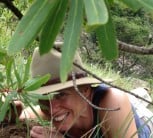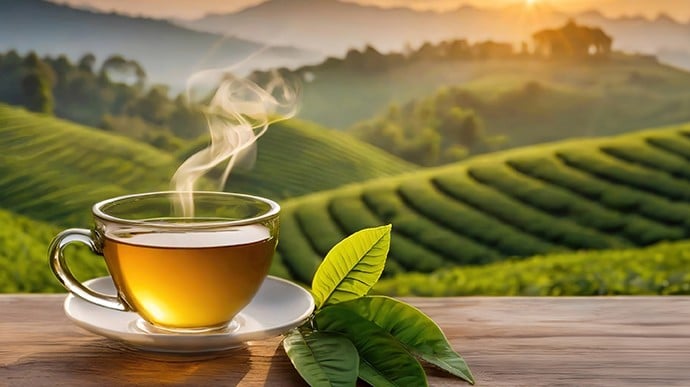Dr Trudy Paap is a participant in the International Plant Sentinel Network who was tasked to do routine surveys for tree pests and diseases in the National Botanical Gardens of South Africa, a project funded by the South African National Biodiversity Institute. It was during one of these surveys that she noticed small lesions resembling shotgun marks on the stems and branches of mature London plane (Platanus x acerifolia) in the historical avenue of the KwaZulu-Natal National Botanical Garden in Pietermaritzburg.
"Upon closer inspection, I found that the lesions developed around entrance holes of small beetles. When I removed the bark, the sapwood was discoloured by a fungus. I brought samples back to the University of Pretoria's Forestry and Agricultural Biotechnology Institute (FABI), and with the assistance of FABI team members, the beetle and fungus were identified based on DNA sequences as Euwallacea fornicatus, or polyphagous shot hole borer (PSHB), and Fusarium euwallaceae, respectively," said Dr Paap.
Polyphagous refers to the ability of the PSHB to infest many different tree species. The results were published in the journal, Australasian Plant Pathology .
Since its discovery in KwaZulu-Natal in 2017, the FABI team has confirmed the presence of the PSHB in eight of the nine provinces of South Africa.
The discovery of this beetle and fungus in South Africa is of major concern to farmers, foresters, landscapers, homeowners and ecologists, as together, these organisms can be aggressive tree killers.
"The most visible impact of the PSHB invasion in South Africa is in urban forests on street, park and garden trees, and this became the focus of many articles in the media. Many trees have been killed by the PSHB in Sandton, George, and Knysna, while reports from Sedgefield, Bloemfontein, Ekurhuleni, Jan Kempdorp, Hartbeesfontein, Pietermaritzburg and Durban suggest that the impact is becoming worse in those areas. The most common trees to be killed are English oak, Chinese maple, Japanese maple, boxelder, and coral trees," said Dr Paap.
Of great concern is the recent discovery of the PSHB on London plane and sweetgum trees in Somerset West in the Cape Peninsula. Oak trees appear to be a favoured reproductive host, and have been severely impacted by this invasive pest; this has been the case especially in the George and Knysna areas, where many large, old specimens have been killed in a relatively short period of time. As such, it seems inevitable that the famous oaks of Stellenbosch and the surrounding wine farms will be dramatically impacted. Other commercial crops like avocados and pecan nuts are also at risk.
It is now known that the beetle is spreading from urban areas into native forests close to the towns of George, Knysna, and Durban. However, which species will be affected and to what extent is unpredictable.
Several native tree species were found to be infested in the gardens of Sandton, George, and Knysna, with species like the coral tree, keurboom and Cape willow being particularly vulnerable and often killed.
FABI researchers are working on several projects to collaborate and try to manage the invasion and to explore ways of possibly containing the spread from a multitude of angles with key role players from representing policy, industry and research.
Click on the following pages below to learn how the trees die, how much it's costing commercial farmers, what UP resesearchers are doing about it, you can watch the video in the sidebar on how you can help the trees or what to do if your trees are infected and a list of the trees that are most at risk of being affected by the polyphagous shot hole borer.
Click on the video in the sidebar to learn what you can do to save your trees from the polyphagous shothole borer, or view images in the gallery to see how different trees are affected.
How do the trees die?
Dr Trudy Paap explains that "The polyphagous shothole borer (PSHB) is a 2 mm long ambrosia beetle that is native to Southeast Asia."
"The female beetle carries three fungal species, one of which is Fusarium euwallaceae. The beetle bores through the bark into the sapwood of the tree and inoculates the fungus into the living wood. The fungus grows in the galleries (tunnels) created by the beetle and serve as a ‘vegetable garden’ for the beetle larvae, but in susceptible trees the fungus can spread through the sapwood causing disease or even death of the tree," she said.
In its native environment in Southeast Asia, it seems as if the beetle and fungus do not cause serious damage. "This is usually the case for insects and microorganisms in their natural environments. As a result of co-evolution between pests and their hosts, together with pressures from competition, predation, and parasitism by natural enemies, damaging outbreaks by pests in their natural environments are rare," said Dr Paap.
When these organisms are moved to novel environments outside of their natural range (usually unintentionally by humans through trade or travel), they have the potential to encounter novel hosts lacking resistance. Worldwide there are many examples of alien forest pests and pathogens arriving and establishing in new environments, resulting in disastrous outbreaks impacting commercial, natural, and urban forests.
Until December 2018 the PSHB was known as Euwallacea nr fornicatus. However, Gomez et al (2019) showed with DNA sequences that Euwallacea fornicatus is actually a species complex including four closely related, but distinct species.
These four species of shot hole borer are very similar in external appearance, and can only be distinguished by specialists with the aid of a microscope, or with DNA sequences. The four species carry different fungal species, and have different host ranges and geographical distributions (Gomez et al 2018).
With South African borders being open for trade to Southeast Asia, there remains a risk that one of the other species can be introduced. Dr Paap explains that "Co-occurring species increase the chances for interbreeding, which may enhance the adaptability of the beetles to new hosts and new environments, posing an even greater threat. We thus need to confirm the identity of the PSHB from each new location or host tree reported in South Africa, with a DNA sequence of the fungus, the beetle, or both, before the host or location is added to the official list."
It is important to distinguish between different types of hosts. Reproductive host trees are trees that the beetle infests and where it successfully establishes a breeding gallery in which the fungus grows, eggs are laid, and larvae develop into mature adults, thus completing the beetle’s life cycle. The majority of reproductive hosts eventually succumb to the disease symptoms caused by the fungus.
Non-reproductive host trees are trees where the beetle attacks, penetrates, and inoculates the fungus that then starts growing in the sapwood. However, the beetle either leaves or dies without reproducing in these trees. We are yet to observe non-reproductive hosts succumb to the disease and die.
A problem when compiling these lists is that sometimes the PSHB can infest a stressed tree (eg, as the result of drought, too much water, root damage, etc). Such a stressed tree might then become a reproductive host, whereas healthy, non-stressed individuals of the same species are barely affected. When trees are assessed for Fusarium disease, and whether or not they are reproductive hosts, other stress factors on the tree should always be considered.
A more complete list of examples of reproductive and non-reproductive host trees can be found in Part 6 of this feature.
Click on the gallery in the sidebar to see how the PSHB creates its galleries or tunnels, where it leaves a fungus for its larvae
Click on the gallery in the sidebar to see the South African Keurboom which is an example of an indigenous tree that is a reproductive host. You will Notice how the PSHB leaves lesions and noticeably affects the tree as it bores its way through, leaving the fungus for its larvae to feed on.
Click on the gallery in the sidebar to see an example of the monkey plum tree which is a South African example of a non-reproductive host.
According to Dr Trudy Paap, "Avocado trees are among the most susceptible agricultural crop trees to PHSB infestation and Fusarium disease. This is based on experiences in California and Israel."
While infestation of backyard avocado trees has been confirmed in Sandton and Knysna, to date the PSHB has not yet been observed in commercial avocado orchards in South Africa (Van den Berg et al 2019).
The only commercial crop on which the PSHB has been detected to date is pecan, though early indications suggest the impact on this tree species may not be severe. Other fruit trees in private gardens on which it has been found include lemon, orange, guava, peach, and grapevine. At this point, however, there is no evidence suggesting that the PSHB poses a threat to these crops, but producers should carefully monitor and report any infestations.
In addition to agriculture, commercial forestry is another sector that is concerned. We have only found small numbers of roadside wattle trees with PSHB infestations in the Southern Cape, with a single roadside eucalyptus tree infested in Sandton. No trees in commercial plantations, including pines, have been detected with the PSHB in South Africa.
Click on the gallery in the sidebar to see how the PSHB affects avocado and pecan nut trees.
“The PSHB as an invasive species is relatively new to science, and has only been studied since the outbreaks in California and Israel in the early 2000s, so there are many unanswered questions about this pest. A better understanding of the beetle, it’s fungal associates, and how they interact in their invaded environment is essential to enhance our ability to manage the problem and reduce its impact,” said Dr Trudy Paap.
The research team at FABI, under the leadership of Prof Wilhelm de Beer, is engaging with various government agencies, municipalities and industries to advise on policy and strategy, and to secure funding for research projects. In the process, they have established a research network including academics from seven other universities who will collaborate on various aspects of the PSHB invasion in the different regions. Projects that are fully funded at present include the monitoring and impact on avocados (Prof Noelani van den Berg), macadamias (Dr Gerda Fourie), pecans (Prof Wilhelm de Beer), botanical gardens (Dr Trudy Paap and Dr Mesfin Gossa), and forestry crops (Dr Trudy Paap and others from the Tree Protection Cooperative Programme).
Ongoing projects that are partially funded include an assessment of the impact of PSHB on native trees and forests in the Southern Cape. This involves Profs Wilhelm de Beer, Francois Roets (Stellenbosch University), and Martin Hill (Rhodes University). Envisaged projects include an exploration of biological control options and assessments of PSHB’s impact on native forests in KwaZulu-Natal, with funding committed by the Department of Environmental Affairs.
In addition, the City of Johannesburg Metropolitan Municipality has committed to supporting two projects on the impact and management of PSHB in urban forests. These projects will be launched in 2020.
Click on the gallery in the sidebar to view more.
The polyphagous shot hole borer (PSHB) is a tiny, invasive black beetle from Asia that has recently been discovered in South Africa. Although only 2 mm in length, this tiny beetle has detrimental consequences for South African trees, as it carries a destructive fungus, Fusarium euwallaceae, from tree to tree.
Watch this short video in the sidebar to find out what you can do to help save the trees in your garden or neighbourhood if you suspect they may be infected by the PSHB.
Here’s a handy list of the tree species which have been known to be infected already.
The list shows current host trees in South Africa on which infestations of the polyphagous shot hole borer have been confirmed. The Latin names of species as well as the common names have been included for reference. The lists are divided by exotic and indigenous species.
The following are host trees in which both the beetles and the fungus establish, and where the beetle successfully reproduces. In most cases, the reproductive hosts will eventually be killed by the fungus.
The following are host trees that are attacked by the beetle and where the fungus establishes, but where the beetle does not successfully breed.
Dr Trudy Paap
July 20, 2020

 Story
Story
University of Pretoria (UP) researchers have found that the antioxidant content of certain types of tea can be likened to that found in recommended portions of fruit and vegetables.
 Infographic
Infographic
Half a cup of black tea, oolong tea or green tea contained the same amount of antioxidants with radical scavenging capabilities (RSC) as that of a 200mg vitamin C tablet.
 Story
Story
The latest issue of the University of Pretoria’s award-winning RE.SEARCH magazine is available now and reflects a shift towards both a fresher design and outlook. This edition is curated under the theme ‘Digital’, and offers a glimpse into some of the fascinating research we’re doing at UP to drive digital leadership and innovation.
Copyright © University of Pretoria 2025. All rights reserved.
Get Social With Us
Download the UP Mobile App